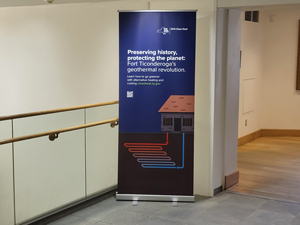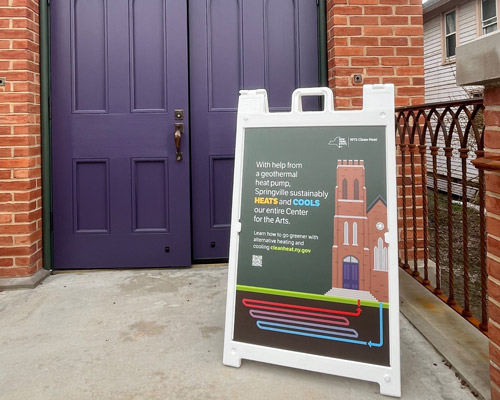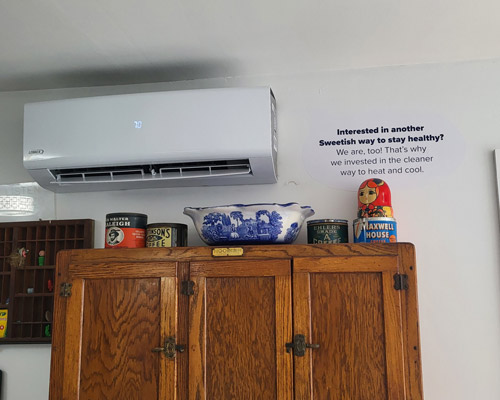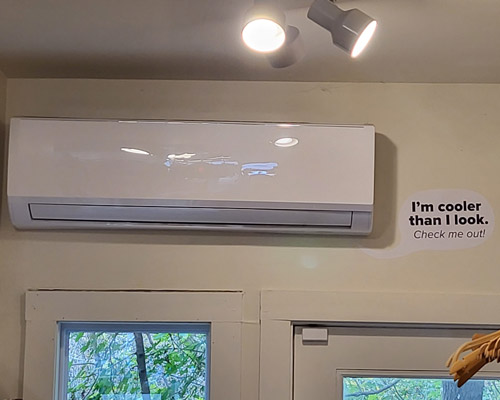Experience the Comfort of Clean Heat

See Firsthand How the Efficient, Emission-Free Technology Works at a Location Near You


Educational signage on Fort Ticonderoga’s
geothermal heat pumps.
Uneven temperatures. Increased humidity. High energy bills. These are some of the telltale signs it’s time to upgrade a heating, ventilation, and air conditioning (HVAC) system.
Homeowners, small businesses, and property owners considering an HVAC replacement may have come across heat pumps in their search. The dual heating and cooling equipment has been surging in popularity for its efficiency and enhanced comfort, outselling gas furnaces for two consecutive years.
With any major purchase though – better yet new technology – having the opportunity to try it out firsthand and speak with customers about their experiences can help answer questions and assuage skepticism. Experience Clean Heat ![]() does just that: connect New Yorkers with local businesses and public spaces to see, feel, and experience how heat pumps deliver year-round comfort.
does just that: connect New Yorkers with local businesses and public spaces to see, feel, and experience how heat pumps deliver year-round comfort.
Here’s a look at where to find Experience Clean Heat locations, plus how buildings with heat pumps can participate and practical tips for property owners and homeowners looking to make the switch.
Hear From Local Businesses and Organizations About Their Heat Pump Experience
More businesses, buildings, and homes are converting to heat pumps every year. Besides their comfort benefits, like precise temperature control and dehumidification, heat pumps can save on energy costs and reduce greenhouse gas emissions.
Here’s what several New York small businesses and public facilities had to say about their experience with clean heating and cooling.
“My motivation for installing a heat pump was mainly to help save on energy costs,” says Britt Young, Owner of The Sweetish Chef. Prior to Experience Clean Heat, visitors to the Ballston Spa bakery may not have immediately noticed the mini-split unit tucked above the cabinet on the right-hand wall. But today, signage highlights the equipment and why the business opted to invested in a cleaner, healthier way to heat and cool. Since installing a mini-split air source heat pump at the bakery, Young has made the switch at home, too, adding that “it’s an all-electric home and the baseboard heating was so expensive.”
Next door, Tree Huggers Childrens Apparel’s warm and welcoming window display invites customers into a cozy and comfortable interior that’s heated and cooled with an air source heat pump. According to Stacy Quinn, Founder of the apparel retailer, “I enjoy that the unit is quiet, efficient, and that I can set it at one temperature for consistent heating or cooling.” Quinn’s prior retail location was heated with a forced-air gas furnace. When comparing the two locations, Quinn notes that “the utility bills were staggering in the winter and the savings with this unit are significant.”
Since Sustainable Sundry in Ballston Spa added educational signage about their heat pumps, Owner Amber Chaves has received an influx of questions from customers, namely inquiries about whether the equipment heats and cools the entire space. “We give a resounding ‘Yes!’, and this always surprises people,” says Chaves, adding that it often opens the conversation with customers about how heat pumps can be a part of their sustainable living efforts. According to Chaves, “switching to a heat pump has been a great decision for our business, providing long-term energy savings and reducing our carbon footprint.”
Visitors to Springville Center for the Arts in Western New York can witness how clean heating and cooling can be integrated into historic buildings. The 19th-century, Late Gothic Revival-style building was originally built as a church with conventional heating systems but is now equipped with geothermal heat pumps for year-round heating and cooling. “As we sought to renovate this former church built in 1869, not only have we made it a comfortable space in summer and winter, but we’ve eliminated our entire gas utility bill,” says Seth Wochensky, Executive Director at Springville Center for the Arts.
In the Hudson Valley, the Town of Taghkanic has retrofitted their town hall and highway garage with heat pumps. According to Betsy Albert and Doug Craig, members of Taghkanic’s Climate Smart Task Force ![]() , the air source heat pump system “heats up and cools down more quickly than the previous oil-fired furnace and window AC units.” The heat pumps have delivered year-round comfort, even maintaining an interior temperature of 68 degrees on a day when outside temperatures dropped to -14 degrees. Converting to heat pumps helped the Town of Taghkanic earn bronze certification through the Climate Smart Communities Program
, the air source heat pump system “heats up and cools down more quickly than the previous oil-fired furnace and window AC units.” The heat pumps have delivered year-round comfort, even maintaining an interior temperature of 68 degrees on a day when outside temperatures dropped to -14 degrees. Converting to heat pumps helped the Town of Taghkanic earn bronze certification through the Climate Smart Communities Program ![]() for efforts to reduce greenhouse gas emissions from municipal operations.
for efforts to reduce greenhouse gas emissions from municipal operations.
Does your business or organization have a heat pump? Find out how you can get involved in Experience Clean Heat ![]() .
.
How to Start Your Heat Pump Journey
Interested in making the switch to heat pumps? First, it’s important to assess building energy performance, consider the equipment options, and unpack the financial incentives to maximize the comfort and value of a heat pump system.
Assess Your Energy Performance and Improve Efficiency
Understanding how your home or business is using energy is a fundamental first step to installing clean heating and cooling.
For homeowners, beginning with a no-cost energy assessment can help pinpoint where a home is wasting energy and flag any health or safety issues. The energy auditor who completes the assessment will provide a list of recommendations to improve the home’s energy efficiency and save energy.
Small businesses and nonprofits can tap access cost-share support from Green Jobs – Green New York to complete a site-specific energy study and identify energy-saving opportunities.
Air sealing and insulation is often an initial upgrade for homes and businesses to reduce leaks and lock in immediate energy savings. Boosting energy efficiency first can also reduce your heat pump installation costs, as a more insulated home can be heated and cooled with a smaller, less expensive system.
Compare Heat Pump Options
There are three main types of heat pumps ![]() . Air source heat pumps and geothermal heat pumps (also known as ground source heat pumps) provide both space heating and cooling, while heat pump water heaters deliver efficient water heating.
. Air source heat pumps and geothermal heat pumps (also known as ground source heat pumps) provide both space heating and cooling, while heat pump water heaters deliver efficient water heating.
While geothermal heat pumps have greater space requirements and upfront costs, they have a longer lifespan and boast the most efficiency for heating and cooling. Meanwhile, air source heat pumps can be installed without ductwork (known as mini-split units) and have less upfront costs, comparatively.
Using the Heat Pump Planner ![]() can help compare options, visualize a heat pump installation, and determine the system that best suits your home’s needs.
can help compare options, visualize a heat pump installation, and determine the system that best suits your home’s needs.
Review Incentives to Lower Costs
All three heat pump technologies qualify for incentives from New York State and the federal government.
NYS Clean Heat rebates ![]() provide upfront discounts for New York residents on qualified equipment installed by a participating NYS Clean Heat contractor. New Yorkers can also leverage low-cost financing through NYS Clean Heat to cover the remaining cost of a home heat pump system.
provide upfront discounts for New York residents on qualified equipment installed by a participating NYS Clean Heat contractor. New Yorkers can also leverage low-cost financing through NYS Clean Heat to cover the remaining cost of a home heat pump system.
Income-eligible New Yorkers can access funding through the EmPower+ Program to lower the upfront cost of a heat pumps, plus energy efficiency improvements and electrical upgrades to optimize the system.
Inflation Reduction Act tax credits are available for businesses, homeowners, and nonprofit organizations that install air source heat pumps, geothermal heat pumps, and heat pump water heaters. Geothermal heat pumps are also eligible for a New York State income tax credit of up to 25% of the project cost, capped at $5,000.
Residents, small businesses, and nonprofits can connect with their Regional Clean Energy Hub to get hands-on assistance navigating program offerings and incentives.
More on New York’s Clean Energy Transition
Continue reading about statewide and local efforts to advance New York’s clean energy economy.
- Transforming Brownfields for a Greener Future: Learn about New York’s work to advance renewable energy development on former industrial sites and underused spaces.
- New York Leads the U.S. on Community Solar: New York’s two gigawatts of community solar provides equitable access to renewable energy for a variety of customers.
- New York Schools Are Going Green: Here’s how one Upstate New York school district is promoting best-in-class energy management and creating healthier learning environments.
- Towns Advancing Clean energy and Efficiency: Municipalities across New York are leading by example in reducing emissions and adopting clean energy in their communities.





